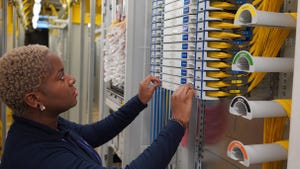Startups cheer open RAN for opening the door
Companies ranging from XCOM-Labs to DeepSig to Airspan Networks cheered open RAN opportunities during a virtual event hosted by the Open RAN Policy Coalition.

"How can we actually break in? Because we are going up against some very large incumbents," wondered Paul Jacobs, CEO of wireless technology startup XCOM-Labs, during a virtual event hosted by the Open RAN Policy Coalition.
Jacobs – formerly the CEO of wireless technology giant Qualcomm and the son of that company's founder – said that open RAN technology is helping to break open opportunities for smaller companies like XCOM-Labs. That's the startup Jacobs and other top Qualcomm executives founded in 2018 after they left the silicon vendor.
And Jacobs isn't the only wireless entrepreneur hoping that open RAN will open up doors into the industry for smaller, upstart vendors.
Opportunities opening up
Open RAN "opens up this entire ecosystem," argued Tim O'Shea, CTO of startup DeepSig. The company is using technologies like artificial intelligence and machine learning to improve radio signal processing in 5G networks. O'Shea said that DeepSig is developing very specialized software, software he believes the company will be able to plug into future 5G networks thanks to the modular structure of open RAN technology.
Similarly, Pivotal Commware CEO Brian Deutsch said that open RAN has given his company a better chance to make an impact. He said the company was often sidelined at the 3GPP, the standards organization charged with developing 5G specifications, because "entrenched interests" were not interested in its technology. But he said Pivotal Commware was welcomed into the open RAN ecosystem, thus creating more opportunities for the startup. "That's what O-RAN has meant to us," he said.
"Smaller participants can be a part of that," agreed Eric Stonestrom, CEO of Airspan Networks. His company provides hardware and software for 5G networks, and is one of the key suppliers to Japan's Rakuten, an early supporter of open RAN technologies. "It is a really exciting time for new startups."
Thus, the message of the Open RAN Policy Coalition – launched last year – was difficult to miss: Open RAN technology helps to foster innovation within the wireless industry. The technology promises to break networks up into their discrete components, thereby allowing network operators to mix and match gear from a variety of vendors. That's a decided change from most radio access network (RAN) designs today, which are typically supplied by one single vendor.
The Open RAN Policy Coalition lists a wide range of members including Verizon, Dish Network, Google and Samsung. And the group's mission is clear: To get US legislators to promote open RAN technologies, whether that's through encouraging the purchase of open RAN equipment, funding open RAN research, or otherwise greasing the wheels of policy.
American enthusiasm
Speakers during the group's virtual event helped to underscore the notion that open RAN technology can help startups, particularly US-based startups.
"US companies need to play a significant role," argued Ray Dolan of Cohere Technologies, another wireless technology startup hoping to catch a ride on the coattails of open RAN.
According to Stonestrom of Airspan Networks, open RAN could help open up the industry to vendors beyond those in the "Nordic alliance." That's a reference to Sweden's Ericsson and Finland's Nokia, two of the world's biggest suppliers of 5G equipment today. He suggested that the wireless industry is on the cusp of a revolution similar to the early days of the PC when a proliferation of vendors helped drive down prices and create new inventions.
"Telecom is actually cool again," agreed Deutsch of Pivotal Commware. He said venture capitalists and other financiers are increasingly entering the industry, partly due to the opportunities around open RAN.
"Ready or not, here we come," he said of open RAN-powered startups like Pivotal Commware.
Related posts:
— Mike Dano, Editorial Director, 5G & Mobile Strategies, Light Reading | @mikeddano
About the Author(s)
You May Also Like












